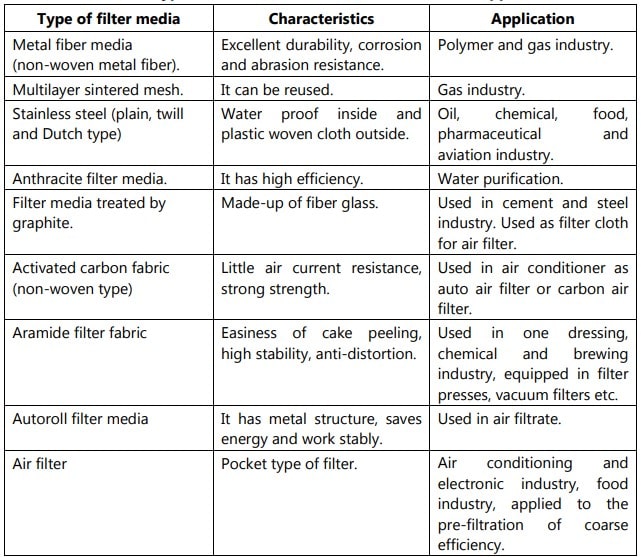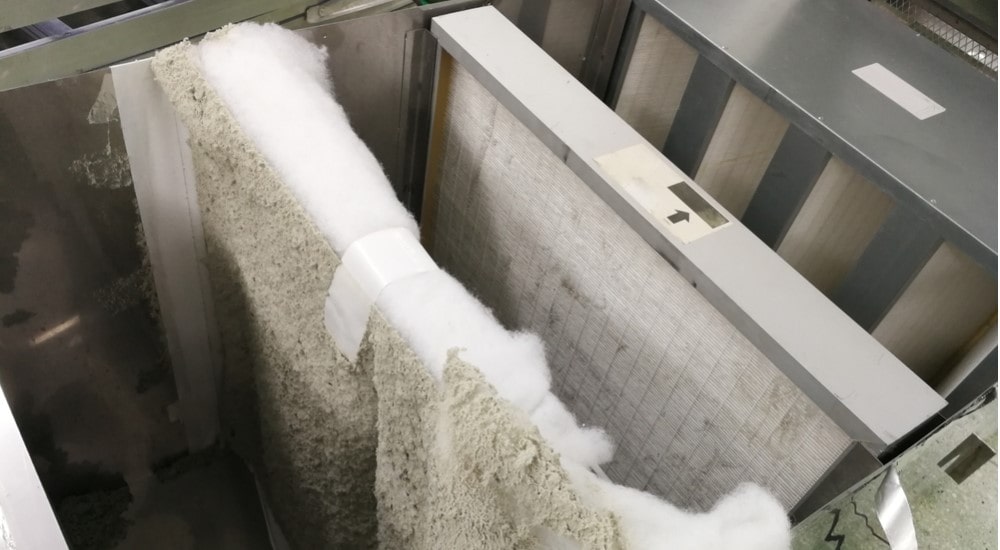The surface upon which solids are deposited on or in a filter is called the “Filter medium”. Filters are used in several different industries, including pharmaceuticals, food and beverages, cosmetics, and chemicals. Without efficient filters, the end products would be of poor quality and the safety element would not be there. The types of filter media and their characteristics are given in the table below.
Table of Contents
Properties of Ideal Filter Medium
(i) It must be capable of delivering a clear filtrate at a suitable production rate.
(ii) It must withstand the mechanical stresses without rupturing or being compressed.
(iii) No chemical or physical interactions with the components of the filtrate should occur.
(iv) It must retain the solids without plugging at the start of filtration.
(v) For sterile filtration the pore size must not exceed the dimension of bacteria or spores.
Classification of Filter Media
The list of some of the main types of filter media that are used to keep products clear, consistent and uncontaminated is given below.
(i) Woven filters:
Woven filters include wire screens and fabrics of cotton, wool, and nylon. Wire screens, for example, stainless steel are durable, resistance to plugging and easily cleaned. Cotton is a common filter, however, Nylon is superior for pharmaceutical use, since it is unaffected by mold, fungus or bacteria and has negligible absorption properties. Bag filter is common examples of this type. Bag filters come in several different varieties, and are best suited for situations where large solids must be removed from a liquid. In this scenario, the liquid would flow through the bag and the solids would get caught inside. Bag filters may be made from a variety of different materials, and are usually available in different lengths and micron ratings to suit whatever job you need it for.
(ii) Non-woven filters
Filter paper is a common example of non-woven filter medium since it offers controlled porosity, limited absorption characteristic, and low cost. A panel filter is non-woven type filter. It is industrial filter that may come in a variety of different shapes and sizes, depending on the application. In the majority of cases, panel filters are plain and are found inside ventilation or air conditioning units.
(iii) Membrane filters
Membrane filters are basic tools for micro-filtration, useful in the preparation of sterile solutions. These filters are made by casting of various esters of cellulose, or from nylon, Teflon, polyvinyl chloride. The filter is a thin membrane with millions of pores per square centimetre of filter surface. A cartridge filter is cylindrical in shape, but occasionally it looks flat. Cartridge filters use a barrier/sift method to remove sediment and harmful solids from liquid. Some cartridge filters are designed to remove microscopic elements and some are designed to stop larger particles from getting into the finished product. Membrane filters are cartridge units and are economical and available in pore size of 100 µm to even less than 0.2 µm. They can be either surface cartridges or depth type cartridges. Surface cartridges are corrugated and resin treated papers and used in hydraulic lines.
For example, ceramic cartridges and porcelain filter candles. They can be reused after cleaning. Depth type cartridges are made-up of cotton, asbestos or cellulose. These are disposable items, since cleaning is not feasible.
(iv) Porous plates
These include perforated metal or rubber plates, natural porous materials such as stone, porcelain or ceramics, and sintered glass. Sintered glass, sintered metal, earthenware and porous plastics are used for fabrication. These are used for its convenience and effectiveness.
(v) Hydraulic Filters
Hydraulic filters are industrial filters that are designed to purify petroleum-based liquids such as oils. These types of filters are often found in a different hydraulic system to prevent a breakdown caused by oil impurities. Hydraulic filters can also be used to purify water-based liquids.
(vi) Strainers
Strainers often become part of the manufacturing process when the process contains solids that are too large to be caught up in other types of filter media. Strainers consist of baskets that can be removed and cleaned out regularly to prevent them from being stucked inside. Some strainers can be cleaned without interrupting the system, while others cause some disruption each time when they are cleaned.
(vii) Air Filters
Air filters are an important part of most industrial processes, as they remove dust, dirt and other particles from the air. Most air filters consist of a mesh that catches the particles when air is forced through. If the air is to be protected from gases and odors as well as particles, a high efficiency particulate air filter is used.
(viii) Gas Filters
Gas filters are a type of industrial filters that helps to remove contaminants or particulates from a dry or liquid gas stream. Depending on the situation, the contaminants may be solid or liquid. Some of the different elements and accessories for gas filters include gas filter separators, coalescers and gas scrubbers.

Theory of filtration
